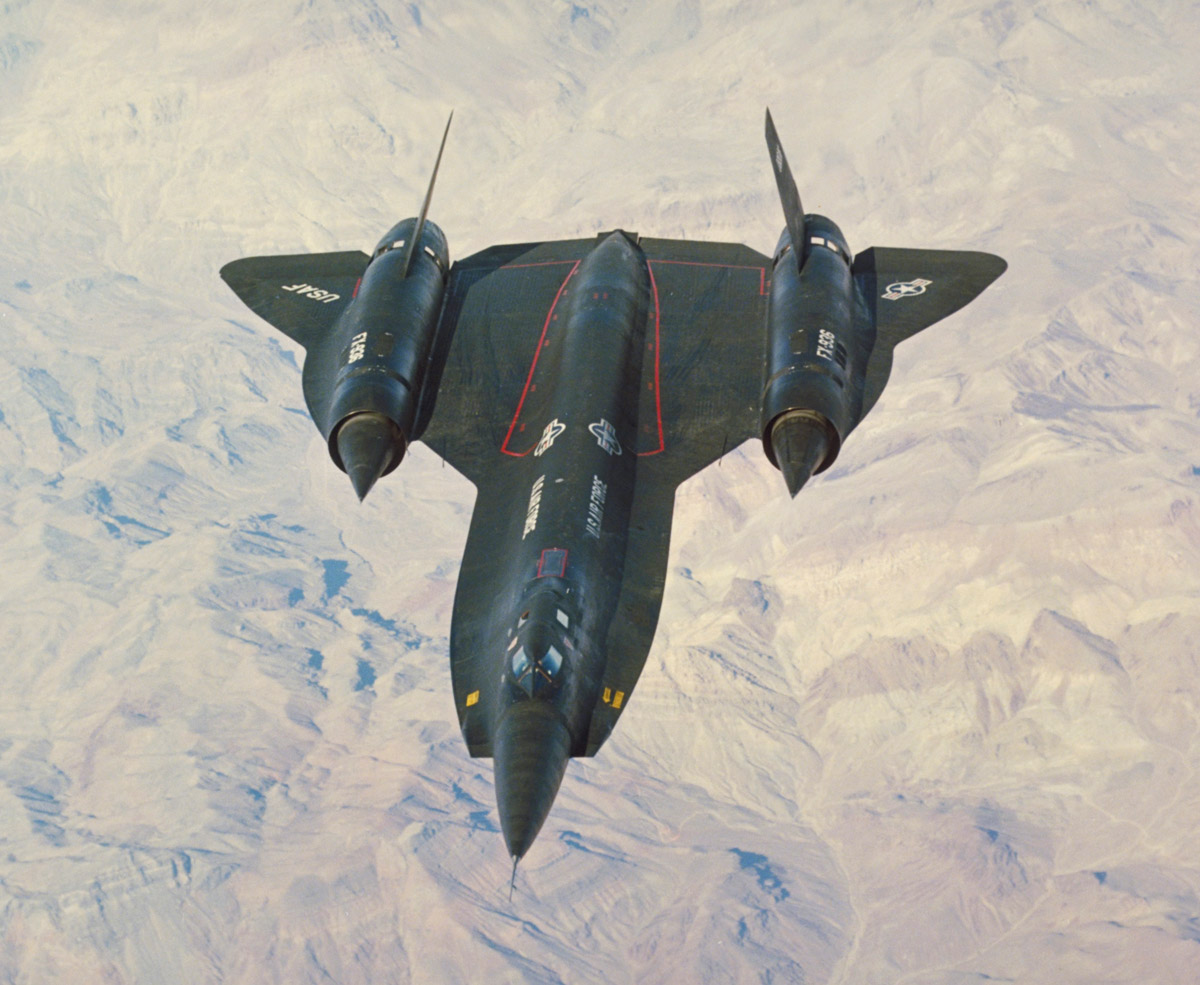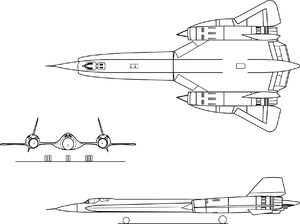| YF-12 | |
|---|---|
| YF-12A undergoing flight testing. | |
| Role | Interceptor |
| Manufacturer | Lockheed Corporation |
| Designed by | Clarence "Kelly" Johnson |
| First flight | 7 August 1963 |
| Status | Cancelled |
| Primary user | United States Air Force |
| Number built | 3 |
| Unit cost | US$15-18 million (projected)[1] |
| Developed from | Lockheed A-12 |
Contents
|
Design and development
In the late 1950s the United States Air Force (USAF) sought a replacement for the F-106 Delta Dart. As part of the Long Range Interceptor Experimental (LRI,X) program, North American Aviation's F-108 proposal, a Mach 3-capable interceptor was selected. However, the F-108 was canceled in September 1959.[2] During this time Lockheed's Skunk Works was developing the A-12 spy plane for the Central Intelligence Agency (CIA) under the Oxcart program. Skunk Works' Kelly Johnson proposed a version of the A-12 called AF-12 by the company and the USAF ordered three AF-12s in mid-1960.[3]The AF-12s would take the seventh through ninth slots on the A-12 production line and have them completed in the YF-12A interceptor configuration.[4] The main changes involved modifying the aircraft's nose to accommodate the Hughes AN/ASG-18 fire-control radar originally developed for the XF-108, and the addition of a second cockpit for a crew member to operate the fire control radar. The nose modifications changed the aircraft's aerodynamics enough to require ventral fins to be mounted under the fuselage and engine nacelles to maintain stability. Finally, four bays previously used to house the A-12's reconnaissance equipment were converted to carry Hughes AIM-47 Falcon (GAR-9) missiles.[5] One bay was used for fire control equipment.[6]
The first YF-12A flew on 7 August 1963.[5] President Lyndon B. Johnson announced the existence of the plane[7][8] on 24 February 1964.[9][10] The YF-12A was announced in part to continue hiding the A-12, its still-secret ancestor; any sightings of CIA/Air Force A-12s based at Area 51 in Nevada could be attributed to the well-publicized Air Force YF-12As based at Edwards Air Force Base in California.[8]
On 14 May 1965 the Air Force placed a production order for 93 F-12Bs for its Aerospace Defense Command (ADC).[11] However, Secretary of Defense Robert McNamara would not release the funding for three consecutive years due to Vietnam War costs.[11] Updated intelligence placed a lower priority on defense of the continental US, so the F-12B was deemed as being no longer needed. Then in January 1968, the F-12B program was officially ended.[12]
Operational history
| This section requires expansion with: Fill in holes on USAF and NASA flight testing. |
USAF testing
During flight tests the YF-12As set a speed record of 2,070.101 mph (3,331.505 km/h) and altitude record of 80,257.86 ft (24,462.6 m), both on 1 May 1965,[9] and demonstrated promising results with their unique weapon system. Six successful firings of the AIM-47 missiles were completed. The last one launched from the YF-12 at Mach 3.2 at an altitude of 74,000 ft (22,677 m) to a JQB-47E target drone 500 ft (152 m) off the ground.[13]The program was abandoned following the cancellation of the production F-12B, but the YF-12s continued flying for many years with the USAF and with NASA as research aircraft.
NASA testing
The initial phase of this program included test objectives aimed at answering some questions about implementation of the B-1. Air Force objectives included exploration of its use in a tactical environment, and how AWACS would control supersonic aircraft. The Air Force portion was budgeted at US$4 million. The NASA tests would answer questions such as how engine inlet performance affected airframe and propulsion interaction, boundary layer noise, heat transfer under high Mach conditions, and altitude hold at supersonic speeds. The NASA budget for the 2.5-year program was US$14 million.[14]Of the three YF-12As, #60-6934 was damaged beyond repair by fire at Edwards during a landing mishap on 14 August 1966; its rear half was salvaged and combined with the front half of a Lockheed static test airframe to create the one and only SR-71C. That aircraft was nicknamed "The Bastard" by its pilots, as it did not fly quite straight. It is unique among SR-71s as it retained the ventral fins under its nacelles from its YF-12 lineage.
YF-12A #60-6936 was lost on 24 June 1971 due to an inflight fire caused by a failed fuel line; both pilots ejected safely just north of Edwards AFB. YF-12A #60-06935 is the only surviving YF-12A; it was recalled from storage in 1969 for a joint USAF/NASA investigation of supersonic cruise technology, and then flown to the National Museum of the United States Air Force at Wright-Patterson Air Force Base near Dayton, Ohio on 17 November 1979.[9]
A fourth YF-12 aircraft, the "YF-12C", was actually the second SR-71A (61-7951). This SR-71A was re-designated as a YF-12C and given a fictitious serial number 60-6937 from an A-12 to maintain SR-71 secrecy. The YF-12C was loaned to NASA for propulsion testing after the loss of YF-12A (60-6936) in 1971. The YF-12C was operated by NASA until September 1978, when it was returned to the Air Force.[15]
Variants
- YF-12A
- Pre-production version. Three were built.[16]
- F-12B
- Production version of the YF-12A; canceled before production could begin.[17]
- YF-12C
- Fictitious designation for a SR-71 provided to NASA for flight testing. The YF-12 designation to keep SR-71 information out of the public domain.[18]
Operators
Specifications (YF-12A)
Data from Lockheed's SR-71 'Blackbird' Family[19]
General characteristics- Crew: 2
- Length: 101 ft 8 in (30.97 m)
- Wingspan: 55 ft 7 in (16.95 m)
- Height: 18 ft 6 in (5.64 m)
- Wing area: 1,795 ft² (167 m²)
- Empty weight: 60,730 lb (27,604 kg)
- Loaded weight: 124,000 lb (56,200 kg[5])
- Max takeoff weight: 140,000 lb (63,504 kg)
- Powerplant: 2× Pratt & Whitney J58/JTD11D-20A high-bypass-ratio turbojet with afterburner (turbo/ramjet hybrid)
- Dry thrust: 20,500 lbf (91.2 kN) each
- Thrust with afterburner: 31,500 lbf (140 kN) each
- Maximum speed: Mach 3.35 (2,275 mph, 3,661 km/h[5]) at 80,000 ft (24,400 m)
- Range: 3,000 mi (4,800 km)
- Service ceiling: 90,000 ft (27,400 m)
- Missiles: 3× Hughes AIM-47A air-to-air missiles located internally in fuselage bays
- Hughes AN/ASG-18 look-down/shoot-down fire control radar
Aircraft disposition
| Serial number | Model | Location or fate |
|---|---|---|
| 60-6934 | YF-12A | Transformed into SR-71C 61-7981 after fire damage in 1966, on display at Hill Aerospace Museum, Hill AFB, UT |
| 60-6935 | YF-12A | National Museum of the U.S. Air Force, Wright-Patterson AFB, OH |
| 60-6936 | YF-12A | Lost, 24 June 1971 |





No comments:
Post a Comment